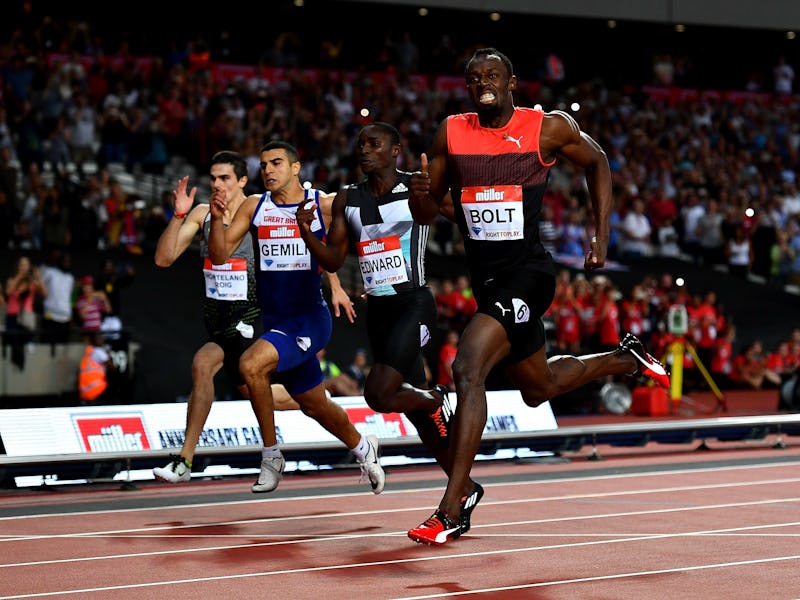
Usain Bolt seems to run impossibly fast: His record time of 9.58 seconds in the 100-meter sprint seems unbeatable — yet that’s what was said about so many of the record holders before.
But surely there must be a hard limit to human speed, after which no more records will be broken? Humans, after all, cannot run infinitely fast.
Peter Weyand, a physiologist who has studied the biomechanics of running for two decades, says no.
“You can always be confident, no matter how fast somebody runs, it’s possible to go faster,” he tells Inverse. “You’re never going to have absolutely perfect conditions and an absolutely perfect person and an absolutely perfect race all come together at the same time.”
Here’s a neat fact: If you can sprint, you can be as fast as Usain Bolt. Back in the late 1990s, Weyand and a team of researchers measured a bunch of different people running at their top speed, and they had something in common: Within a very small margin, they all took the same amount of time to swing a leg through the stride from back to front. “Whether you’re fast, slow, or in between, the repositioning time for the limb at top speed is basically the same,” he says.
Usain Bolt crosses the finish line to win gold in the 4x100 meter relay at the IAAF World Athletics Championships Beijing in 2015.
It’s a natural assumption to believe that in order to run faster, you need to move your legs faster. But it’s not true. So how come Bolt tops out at 27.8 miles per hour and your legs feel like they’re about to give out once you go just above a jog?
It all comes down to how forceful you are. The higher the impact force of each footfall, the higher the runner launches into the air, and the further they go before striking land again. Elite runners, at top speeds, actually push somewhere in the neighborhood of 1,000 pounds of force per footfall — that’s half a ton.
At this point, it’s fair to take a step back and wonder if this is all crazy talk. How can pounding weight down actually make you faster? And isn’t forceful running the opposite of the “light,” aerodynamic quality the latest running shoes seem to espouse? Don’t your leg muscles and joints and tendons give out if you’re slamming all that force onto them?
It puzzled Weyand’s team too. But research by the group found that when you hop forward on one foot, the force of impact with each landing is about a third stronger than it is in a sprint. Runners’ legs could take a lot more force than we think.
What stops them is time. Elite sprinters spend the same amount of time as you do in the air per stride, but they spend less time actually touching the ground. This makes sense — if Usain Bolt is moving twice as fast you are, then he only has about half as much time to connect with the ground as the track zooms by underneath his feet. So he has to apply a lot more pressure than you do with each strike, but has a lot less time to do it in.
This is the real limiting factor to human speed — not the application of pressure itself but the rate of its application. Bolt is exceptional not in his ability to swing his legs forwards and backwards, but in his ability to very quickly punch the ground and get back up off of it. This is limited by response times of fast-twitch muscle fibers in the leg.
Weyand estimates that, if there were some way to enhance the responsiveness of leg muscles to the point where we ran to the limit of our legs to absorb the shock, humans could run 40 miles an hour or faster. But this is purely theoretical; the fact is that no one, so far, has figured out how to make legs punch faster and harder than Usain Bolt.
An infinite number of variables play into the outcome of a race.
But someone, someday, will.
There are so many different interventions to take in the quest for higher speeds. Smarter training and nutrition are one thing, but there are also factors outside of the body — like running shoes, starting blocks, and track material — that make a huge difference. These have very little to do with the mechanics or capabilities of the human body, but they make an enormous difference.
The limits are mostly defined not by our bodies, and they also depend heavily on the parameters we set to decide on what sorts of interventions are acceptable in pushing human speed further. Did you break the speed record if you ran down a hill? If the wind was at your back? If you took performance-enhancing drugs? If you were genetically engineered to build stronger, faster leg muscles?
Weyand doesn’t see a future where records stop being broken; there are just too many different ways to legally influence performance through better training and better technology. “Those interventions have become more and more powerful, and probably will continue to do so, and they need to, if the records are going to continue to tumble. So as long as there is economic incentive, as there is, in science and technology moves forward, there are going to be more and more powerful ways to enhance performance.”
There is no limit to human speed. There is no unbreakable record. The only limit is the resources we’re willing to spend trying in an effort to break them.